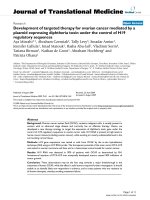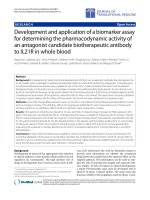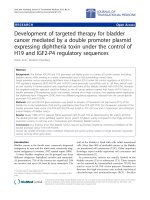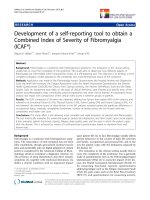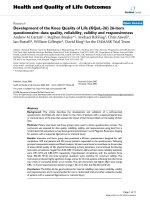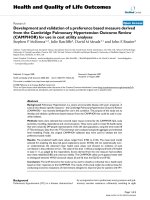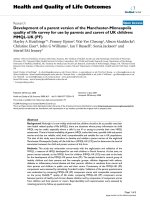Báo cáo hóa học: " Development of a parent version of the Manchester-Minneapolis quality of life survey for use by parents and carers of UK children: MMQL-UK (PF)" potx
Bạn đang xem bản rút gọn của tài liệu. Xem và tải ngay bản đầy đủ của tài liệu tại đây (253.76 KB, 8 trang )
BioMed Central
Page 1 of 8
(page number not for citation purposes)
Health and Quality of Life Outcomes
Open Access
Research
Development of a parent version of the Manchester-Minneapolis
quality of life survey for use by parents and carers of UK children:
MMQL-UK (PF)
Hayley A Hutchings*
1
, Penney Upton
2
, Wai-Yee Cheung
1
, Alison Maddocks
3
,
Christine Eiser
4
, John G Williams
1
, Ian T Russell
5
, Sonia Jackson
6
and
Meriel EM Jenney
7
Address:
1
School of Medicine, Swansea University, Swansea, UK,
2
Institute of Health, Social Care and Psychology, University of Worcester,
Worcester, UK,
3
National Public Health Services for Wales, Carmarthen, UK,
4
Child and Family Research Group, Department of Psychology,
University of Sheffield, Sheffield, UK,
5
Institute for Medical and Social Care Research, University of Wales Bangor, Bangor, UK,
6
Thomas Coram
Research Unit, Institute of Education, University of London, London, UK and
7
Department of Child Health, Cardiff and Vale NHS Trust, Cardiff,
UK
Email: Hayley A Hutchings* - ; Penney Upton - ; Wai-Yee Cheung - ;
Alison Maddocks - ; Christine Eiser - ; John G Williams - ;
Ian T Russell - ; Sonia Jackson - ;
Meriel EM Jenney -
* Corresponding author
Abstract
Background: Although it is now widely endorsed that children should as far as possible rate their
own health related quality of life (HRQL), there are situations where proxy information on child
HRQL may be useful, especially where a child is too ill or young to provide their own HRQL
assessment. There is limited availability of generic HRQL scales that have a parallel child and parent
version and that are reliable, valid, brief, comprehensible and suitable for use in UK populations.
The aims of this study were therefore to develop and validate a parent version of the anglicised
Manchester-Minneapolis Quality of Life child form (MMQL-UK (CF)) and to determine the level of
association between the child and parent versions of this form.
Methods: This study was undertaken concurrently with the anglicisation and validation of the
MMQL, a measure of HRQL developed for use with children in North America. At that time, no
parent version existed, so the MMQL form for children (MMQL-UK (CF)) was used as the basis
for the development of the MMQL-UK parent form (PF). The sample included a control group of
healthy children and their parents and five exemplar groups; children diagnosed with asthma,
diabetes or inflammatory bowel disease and their parents, children in remission from cancer and
their parents and children in public care and their carers. Consistency of the MMQL-UK (PF)
components were assessed by calculating Cronbach's alpha. Validation of the parent questionnaire
was undertaken by comparing MMQL-UK (PF) component scores with comparable components
on the proxy PedsQL™ quality of life scales, comparing MMQL-UK (PF) component scores
between parents of healthy and chronic disease children and by comparison of component scores
from children and their parents or carers. Reproducibility and responsiveness were assessed by
retesting parents by follow-up questionnaires.
Published: 28 February 2008
Health and Quality of Life Outcomes 2008, 6:19 doi:10.1186/1477-7525-6-19
Received: 12 June 2007
Accepted: 28 February 2008
This article is available from: />© 2008 Hutchings et al; licensee BioMed Central Ltd.
This is an Open Access article distributed under the terms of the Creative Commons Attribution License ( />),
which permits unrestricted use, distribution, and reproduction in any medium, provided the original work is properly cited.
Health and Quality of Life Outcomes 2008, 6:19 />Page 2 of 8
(page number not for citation purposes)
Results: A total of 874 children (completing MMQL-UK (CF)) and 572 parents or carers
(completing MMQL-UK (PF)) took part in the study. The internal consistency of all the MMQL-UK
(PF) components exceeding the accepted criterion of 0.70 and the construct validity was good with
moderate correlations being evident between comparable components of the MMQL-UK (PF) and
the proxy PedsQL™. Discriminant validity was demonstrated with significant differences being
identified between parents of healthy children and those with chronic conditions. Intra-class
correlations exceeded 0.65 for all MMQL-UK (PF) components demonstrating good
reproducibility. Weak to moderate levels of responsiveness were demonstrated for all but social
functioning. The MMQL-UK (PF) showed moderate parent-child correlation with the MMQL-UK
(CF) for all components. The best correlations were seen for those components measuring the
same construct (Pearson's r ranged from 0.31 to 0.61, p < 0.01 for equivalent components).
Conclusion: The MMQL-UK (PF) showed moderate to good correlations with the MMQL-UK
(CF) component scores. The MMQL-UK (PF) will be of use when comparing child and parent/carer
perception of the impact of a child's condition on their HRQL or where the child is too ill or young
to provide their own report.
Background
The measurement of health-related quality of life (HRQL)
is increasingly becoming part of the overall assessment of
a patient's health both in the clinical and the research set-
ting, as it provides a more complete picture of the health
of the patient. Measuring HRQL includes assessing the
patient's perceptions of their physical, emotional and
social health and function that can supplement clinical
information on their health status.
It is now widely endorsed that children as far as possible
should rate their own HRQL [1,2]. However, there is some
suggestion that children may not be able to provide accu-
rate and reliable assessments of their HRQL [3] and that
this may be due to problems understanding the questions,
lack of understanding of the disease itself or time percep-
tion differences [4]. Assessment of HRQL in children may
also be compromised by their age and development and
by their ability to complete lengthy questionnaires [5].
There are conflicting views regarding the benefits of using
proxies for measuring HRQL. There is some doubt as to
whether proxy reports provide an accurate reflection of
the child's HRQL [3,6-8]. Patient and proxy reports may
differ because of the lack of parallel content in the instru-
ments used [9]. Some studies have highlighted limited
concordance between child and parent reports [9-12]
whilst others have reported more complementary infor-
mation from children and their parents [7,13]. What is
important about proxy ratings is understanding when par-
ents are able to provide useful information. This is more
likely to be in relation to impact of HRQL on the family,
sibling relationships and to a lesser extent school progress
[14]. Parents' knowledge of their child is likely to be more
limited in relation to activities or relationships that exist
outside home and with respect to internal feeling states
[9,10,12]. Parents also have a role to play when a child is
too young or ill to provide a HRQL assessment. It has
been suggested that consistent parent-proxy reports may
prove to be more reliable and valid in longitudinal HRQL
and long-term outcome investigations than their chil-
dren's own reports alone because of the rapid changes in
children's attitudes, abilities, and priorities as part of the
normal developmental process [15]. The solution is to
regard both child and parental assessment as valid and
contributing to the total picture regarding the child's
HRQL [14].
When measuring the HRQL of children it may be neces-
sary or desirable to obtain reports from their parents [10].
Clinicians often look to parents for guidance regarding
their child's HRQL as they play an important role in med-
ical decision making [16]. It is important that the clinician
is confident in a parent's evaluation of their child's HRQL.
If a child is unable to provide HRQL judgements, drawing
on alternate sources of information regarding a patient's
HRQL may be a useful source of information provided
that additional information is available to support the
validity of the proxy ratings [16]. Even when a child's
responses are available, the perspective of the parent has
an important bearing on health care decisions with
respect to the child. For these reasons, parallel reporting is
increasingly recommended in studies involving the assess-
ment of health outcomes in child populations with anal-
ogous questionnaires for children and their parents being
developed [10].
In spite of this, may measures of child HRQL do not
include parallel parent versions [17,18]. For this reason,
we report the development and validation of a parent ver-
sion of the Minneapolis-Manchester Quality of Life
Instrument (MMQL-UK (PF)) that could be used in paral-
lel with the child version to assess the HRQL of children
Health and Quality of Life Outcomes 2008, 6:19 />Page 3 of 8
(page number not for citation purposes)
with chronic conditions, those in public care and their
healthy peers.
Methods
Study questionnaires
Minneapolis-Manchester Quality of Life Instrument (MMQL)
This questionnaire was originally developed in the US for
use with child cancer survivors [19]. The original version
of the MMQL had three different forms, one for children
aged 8–11 (Child form, MMQL-CF), one for 12–18 year
olds (Youth Form, MMQL-YF) and one for young people
aged 19–25 years. All the original child MMQL forms
measured the components of physical functioning, psy-
chological functioning, social functioning, cognitive func-
tioning, body image and outlook on life. Intimate
relations was an additional component in the question-
naires for 12–18 and 19–25 year olds. No parent form is
available for the original MMQL forms. The anglicised
MMQL-UK (CF) version of the questionnaires (based on
the 12–18 year age group) was used as the basis for the
development of the parent form (MMQL-UK (PF)). This
measured the components of physical appearance, school
functioning, social functioning, emotional functioning
and physical functioning [20].
PedsQL™ version 4.0 core module
PedsQL™ measurement system is a modular approach to
measuring HRQL in children and adolescents and their
parents which is rapidly becoming established in the US
and Europe [21,22]. Anglicised versions are also available
[13]. It consists of a brief, practical generic core module,
which is complemented by a number of condition specific
measures. Reliability and validity of the generic core mod-
ule has been demonstrated [22]. PedsQL™ measures the
components of physical functioning, emotional function-
ing, social functioning and school functioning. Parents or
carers were asked to complete this core module as part of
the validation of the newly developed parent MMQL-UK.
Study population
This study was carried out in the context of a wider study
to anglicise and shorten the Manchester-Minneapolis
Quality of Life Survey for children (MMQL-UK (CF))[20].
The MMQL-UK (CF) was used as the basis for the devel-
opment of an adult form (MMQL-UK (PF)).
Before wider administration of the MMQL-UK (PF) could
take place, the phrasing of the questions from the child
form had to be modified to make them adult oriented.
This was done by qualitative methods. An opportunistic
sample of 15 parents of school children (age range 10–18)
were recruited for interviews from a local school known to
one of the researchers (PU) for development of the
MMQL-UK (PF). During the interviews parents were
asked to comment on the wording and structure of the
questionnaire as well as completing a draft parent form.
Interviews were carried out either at the home or at Swan-
sea University, depending on the preference of the parent.
The newly developed MMQL-UK (PF) was then compared
with the shortened and anglicised version of the MMQL-
UK (CF). This paper concentrates specifically on the vali-
dation of the MMQL-UK (PF) and comparison with the
child (CF) version. The Anglicisation and validation of the
MMQL-UK (CF) is reported elsewhere [20]. Although the
original MMQL form was developed to measure HRQL in
cancer survivors the anglicised MMQL-UK (CF) was devel-
oped for use with both healthy and chronic conditions.
The MMQL-UK (PF) was therefore developed to be suita-
ble for the same populations (i.e. healthy and chronic
conditions).
Children and their parents or carers who met the inclu-
sion criteria (see Table 1) were approached to take part in
the study comparing the child and parent MMQL. Four
chronic conditions (asthma, diabetes, chronic inflamma-
tory bowel disease (IBD) and allogenic bone marrow
transplant (BMT) following acute lymphoblastic leukae-
mia (ALL)) were chosen as exemplars for the study. In
addition 'looked after' children in public care were
recruited as a fifth exemplar. These groups were chosen to
ensure a cross section of conditions varying in chronicity
and degree of self-care involved and for their diverse
impact on the different domains of childhood HRQL.
Children with a chronic health problem were identified
with the guidance of collaborating clinicians. Children in
Table 1: Inclusion criteria for children and parents entering the study
Group Inclusion criteria
Asthma Children aged 8–18 years with moderate/severe asthma according to definitions given by the British Thoracic Society and their
parents
Diabetes Children aged 8–18 with Type 1 Diabetes Mellitus and their parents
IBD Children aged 8–18 fulfilling diagnostic criteria for Crohn's Disease and Ulcerative Colitis and their parents
BMT Children aged 8–18 years at least six months post treatment for ALL and their parents
Public care Children aged 8–18 years in public care and their carers
Controls Healthy children aged 8–18 years from local schools
Health and Quality of Life Outcomes 2008, 6:19 />Page 4 of 8
(page number not for citation purposes)
public care were identified through looked after assess-
ments.
Where possible, written information was sent out to the
families of children with a chronic health condition one
week before a routine outpatient appointment. On
attendance at the clinic, a researcher provided a further
verbal explanation of the study, took written consent and
supervised completion of the questionnaires. Families of
children not due in clinic during the data collection
period were sent written information along with a reply
form on which they could indicate their interest in the
study. Telephone contact was made with families
responding positively, to provide further verbal feedback
about the study. Arrangements were made for families
agreeing to take part to complete the questionnaire either
in clinic or at home. Children in public care and their car-
ers were provided with verbal and written information
when attending paediatric assessments. If families
expressed an interest in the study, arrangements were
made for a home visit, where the interviewer gained
informed consent and questionnaires were completed.
Participants for the control group were recruited from
schools in Swansea, Neath, Port Talbot and Bridgend
(Wales, UK). The control group were healthy children
(and their parents) who were not currently using health
care resources for any serious condition. Participants were
given a screening questionnaire prior to participation that
included a section about health status. Anyone who was
identified as having a health problem was excluded from
participation in the study. Permission to approach
schools was obtained from the Directors of Education in
each Local Education Authority, before selecting schools
via multi-stage sampling. Information was sent to head
teachers of sampled schools, inviting their school to par-
ticipate. A researcher visited schools expressing an inter-
est, to discuss the project further and arrange for data
collection. Written information for parents, parental con-
sent forms and parent questionnaires were supplied for
each child to take home. Parents were asked to complete
their questionnaires at home and return them to school
by a specified date, along with consent for their child to
complete the questionnaires. It was emphasised that com-
pletion of questionnaires should not involve consultation
with the child. For those children that had parental con-
sent, re-explanation and completion of questionnaires
followed in class a week later, under the supervision of the
researcher.
In both subject and control groups, children with moder-
ate to severe learning difficulties and children and parents
for whom English was not their first language were
excluded from the study.
The study was approved by the Welsh Multi-centre
Research Ethics Committee (MREC). Informed consent
was sought from all children (subjects and controls) and
their parents or those with parental responsibilities (for
children less than 16 years of age), following oral and
written explanation of the study.
Analysis
Data were analysed using the Statistical Package for Social
Sciences (SPSS) version 11.4.
Assessing internal consistency
The internal consistency of the MMQL-UK (PF) compo-
nents were assessed by item-total correlations and Cron-
bach's alpha [23]. Questions yielding item-total
correlations below 0.4 were considered for rejection [24].
Questions were also considered for rejection if more than
75% of individuals gave the same response, because such
questions are not sensitive enough to discriminate
between different levels of severity [24]. Questions were
also considered for exclusion if they were disliked or con-
sidered difficult to answer by the parents completing
them. Cronbach's alpha for each of the resulting compo-
nents should exceed 0.7 [25]. Principal components anal-
ysis was then performed on the parent content without
any restrictions on the data and the structure was com-
pared to the emergent structure from the child form. This
was carried out in order to validate the underlying compo-
nents of the MMQL-UK (PF).
Assessing validity
The construct validity of the MMQL-UK (PF) components
were assessed by comparing them with the appropriate
parent PedsQL™ quality of life scales. If the components
were valid measures of HRQL, they would be expected to
show significant small to moderate levels of correlation
with each of the PedsQL™ scales, with the largest correla-
tions being seen between the PedsQL™ scales measuring
physical, social, emotional and school function and the
comparable MMQL-UK (PF) components.
The discriminant validity of the MMQL-UK (PF) was
assessed by comparison of component scores between
parents whose children were being treated and the parents
of the control group. Our a priori hypothesis was based on
identifying moderate to large differences in effect size
between each exemplar and the control group [26]. If the
components were valid measures of HRQL, the exemplar
groups would be expected to score lower on the MMQL-
UK (PF) components than the control group. Independ-
ent samples t-tests with Bonferroni corrections were used
to compare control and exemplar groups. Differences in
component score between the exemplars and control
groups were also reported as effect sizes where 0.2–0.49
represented a small difference, 0.5–0.79 represented a
Health and Quality of Life Outcomes 2008, 6:19 />Page 5 of 8
(page number not for citation purposes)
moderate difference and greater than 0.8 represented a
large difference [26].
The relationship between the MMQL-UK (CF) and
MMQL-UK (PF) was determined using Pearson's correla-
tion. If the two reports measure the same concept, then
moderate correlation would be expected between the
component scores of the MMQL-UK (CF) and the MMQL-
UK (PF).
Assessing reproducibility
Following initial completion of the MMQL-UK (PF) by
parents of the exemplar group children, they were asked to
complete a second 'retest' questionnaire the next time
their child visited clinic. This was a maximum of three
months after the first assessment. In addition to complet-
ing the MMQL-UK (PF), the parents of children were
asked to rate whether they thought their child's health had
changed (improved, got worse or stayed the same) since
the first questionnaire was completed. Those parents
reporting no change were included in the reproducibility
analysis. Reproducibility was assessed using intra-class
correlation co-efficient [27].
Assessing responsiveness
The responsiveness of the MMQL-UK (PF) was assessed by
using the scores of the exemplar group parents who
reported a change in their child's health. The response
ratio (mean change in scores for subjects reporting a
change divided by the standard deviation of the subjects
reporting no change) was used to quantify the responsive-
ness [27]. The larger the ratio, the more responsive the
instrument.
Results
In order to have a parallel proxy report, question selection
for the parent form replicated that for the child form. A
total of 29 questions were selected for the anglicised and
shortened MMQL-UK (CF) and MMQL-UK (PF) with five
proposed components: physical appearance, school func-
tioning, social functioning, emotional functioning and
physical functioning.
874 children and 572 parents completed the MMQL-UK
(CF) and MMQL-UK (PF). The internal consistency of the
MMQL-UK (PF) was excellent, with all components
exceeding the accepted criterion of 0.70 (see Table 2)
The construct validity of the MMQL-UK (PF) was good,
with significant correlations being evident between the
MMQL-UK (PF) and the proxy PedsQL™ on those scales
measuring similar constructs, i.e physical functioning,
emotional functioning, social functioning and school
functioning (see Table 3).
Table 4 illustrates significant differences between the
mean component scores for the parents of control and
exemplar groups. All exemplar proxies reported lower
HRQL for physical functioning than controls. Proxy phys-
ical appearance scores were significantly lower for the dia-
betes, cancer and IBD groups compared with controls and
proxy emotional functioning reported by parents was
lower for all children with a chronic health problem when
compared with controls. Proxy school functioning scores
were significantly lower compared with controls for the
cancer group and those in public care and proxy social
functioning was significantly lower for the cancer group
and those in public care than for controls.
Intra-class correlations ranged from 0.65–0.91 for the
MMQL-UK (PF) components demonstrating good repro-
ducibility for the questionnaire (see Table 5)
Weak to moderate levels of responsiveness were demon-
strated for all components except social functioning, with
ratios for emotional and physical functioning reaching
significance. The negative ratio for social functioning
however, suggested that reported changes in HRQL were
in the opposite direction to changes in health status (see
Table 6)
Table 7 illustrates the correlations between the MMQL-UK
(CF) and the MMQL-UK (PF) for all the controls and
exemplar groups. The individual exemplar groups were
examined in addition to the whole group to determine if
the correlation patterns were similar. We were particularly
interested in the looked after children group as the proxy
form was completed by the carer as opposed to the par-
ents as in the other exemplar groups. All the groups
showed similar correlations and as such the data were
Table 2: Internal consistency of the MMQL-UK (PF) component
Scale Minimum corrected item- component correlation Maximum corrected item-component correlation Cronbach's alpha
Physical Appearance 0.53 0.71 0.90
School Functioning 0.37 0.83 0.93
Social Functioning 0.64 0.78 0.90
Emotional Functioning 0.35 0.56 0.75
Physical Functioning 0.26 0.64 0.77
Minimum and maximum values represent the lowest and highest scores for the individual components of each of the sub-scales.
Health and Quality of Life Outcomes 2008, 6:19 />Page 6 of 8
(page number not for citation purposes)
Table 3: Correlations between the MMQL-UK (PF) and the PedsQL™ proxy-report components
MMQL-UK (PF)
PedsQL™ Proxy-report Physical Appearance School Functioning Social Functioning Emotional Functioning Physical Functioning
Physical Functioning 0.27** 0.19** 0.28** 0.23** 0.34**
Emotional Functioning 0.28** 0.25** 0.36** 0.61** 0.19**
Social Functioning 0.34** 0.30** 0.50** 0.41** 0.40**
School Functioning 0.17** 0.58** 0.29** 0.24** 0.28**
** Significant at the 0.01 level
Table 4: Mean scores (Standard Deviation) for the MMQL-UK (PF) components for the different patient groups and controls
MMQL-UK (PF) Control (n = 296) Asthma (n = 37) Diabetes (n = 70) Cancer (n = 42) IBD (n = 56) Public Care (n =
71)
Physical
Appearance
76.9 (22.26) 64.9 (31.8) ES 0.54 67.7 (25.3)* ES
0.50
56.8 (23.6)** ES
0.99
59.5 (25.8)** ES
0.83
69.5 (25.8) ES 0.42
School Functioning 76.2 (26.0) 73.1 (26.5) ES 0.11 73.4 (25.7) ES 0.11 45.2 (33.9)** ES
1.02
68.8 (26.0) ES 0.28 52.0 (32.0)** ES
0.83
Social Functioning 86.4 (16.1) 84.6 (20.3) ES 0.10 87.1 (16.6) ES -
0.04
78.3 (16.9)* ES
0.50
83.0 (16.4) ES 0.21 73.5 (25.0)** ES
0.61
Emotional
Functioning
69.1 (11.6) 63.1 (13.9)* ES =
0.47
62.1 (13.3)** ES =
0.56
60.7 (11.3)** ES =
0.73
59.7 (16.6)** ES =
0.66
67.5 (18.8) ES =
0.10
Physical
Functioning
86.8 (16.8) 56.5 (28.0)** ES =
1.31
80.4 (18.0)* ES =
0.37
55.6 (29.5)** ES =
1.30
55.9 (27.8)** ES =
1.28
78.2 (20.7)** ES =
0.46
Independent samples t-test with Bonferroni correction for multiple comparisons.
** Significant at the 0.01 level.
*Significant at the 0.05 level.
ES = effect size: small = 0.2–0.49; moderate = 0.5–0.79; large>0.8 [26]
Table 5: Reproducibility of the MMQL-UK (PF) components for parents reporting no change in their child's health status (N = 50)
Component Mean difference (SD) retest-test 95% CI for the difference Intraclass correlation
Physical Appearance 1.40 (17.76) -3.65 to 6.45 0.77
School Functioning -0.07 (16.44) -4.79 to 4.65 0.84
Social Functioning -1.50 (15.38) -5.87 to 2.87 0.65
Emotional Functioning 0.35 (12.61) -3.24 to 3.93 0.75
Physical Functioning -0.16 (11.76) -3.44 to 3.24 0.91
Table 6: Responsiveness of the MMQL-UK (PF) components for parents reporting an improvement or deterioration in their child's
health status
Scale Mean difference for subjects
reporting a change (n = 19)
Two tailed significance SD of the scores of the stable
subjects (n = 50)
Responsiveness ratio
Physical Appearance 5.00 0.15 17.76 0.28
School Functioning 4.70 0.207 16.44 0.29
Social Functioning -0.66 0.67 15.38 -0.04
Emotional Functioning 7.71 0.003** 12.61 0.61
Physical Functioning 12.63 0.017* 11.76 1.07
** Significant at the 0.01 level.
*Significant at the 0.05 level
Health and Quality of Life Outcomes 2008, 6:19 />Page 7 of 8
(page number not for citation purposes)
analysed as one group. Statistically significant moderate
to good correlations were seen for all five components
between the MMQL-UK (CF) and the MMQL-UK (PF).
Discussion
A parent version of the MMQL (MMQL-UK (PF)) was suc-
cessfully developed based on the anglicised and shortened
child version which has been recently validated in the UK
(MMQL-UK (CF))[20]. The parent version was developed
in parallel with the child version with only minor modifi-
cations being made to the wording of the questions.
Good internal reliability was found for the MMQL-UK
(PF), with alphas exceeding 0.70 for all the components,
thus making them acceptable for group comparisons [25].
Construct validity of the MMQL-UK (PF) was established
through moderate correlations with the parent PedsQL™
core module.
Discriminant validity was demonstrated for the MMQL-
UK (PF) proxy report with differences being noted in
HRQL by parents of healthy children and children with
chronic health conditions and carers of children in local
authority care. The reproducibility and responsiveness of
the MMQL-UK (PF) were indicated by good test-retest
results. The relationship between the MMQL-UK (CF) and
MMQL-UK (PF) was confirmed by moderate correlations
indicating that the two reports measure the same concept.
The availability of a proxy report is important as there may
be occasions when a child is either unable or unwilling to
complete a HRQL measure. However interpretation of
proxy reports should be undertaken with caution as they
may not accurately reflect the child's view, particularly for
some components. However if they are used in conjunc-
tion with a clinical consultation or other objective assess-
ments they could potentially provide useful information
on the health of the child [16].
It should be recognised that both child and proxy ratings
have value but the question is to clarify how differences in
perception of HRQL arise between the child and the proxy
[5]. It has been contested that disagreement is not neces-
sarily undesirable and multiple viewpoints can be valid
and informative [28]. Caregivers may recognize func-
tional limitations that patients are unaware of or deny.
Arguably, assessments of HRQL that are used to inform
decision making in health care based on community-
based preferences need not be restricted to the patient per-
spective [29].
It is recommended that parent proxy reports be available
for child HRQL measures, a condition that the PedsQL™
also fulfils. The availability of proxy-reports in addition to
child reports may be more desirable than reports from the
child alone. In medical consultations, the clinicians often
look to the parents for guidance regarding medical deci-
sion making in relation to their children [16]. The parent
view of their child's HRQL can be informative and provide
an alternative viewpoint [28].
Further studies are needed to determine the accuracy of
the MMQL-UK (PF) proxy reports compared with the
MMQL-UK (CF) child reports in other conditions and dif-
ferent age groups of children. The usefulness of the
MMQL-UK (PF) in assessing longitudinal outcomes of
children also warrants further attention.
Conclusion
This study established the reliability and validity of a new
MMQL proxy report (MMQL-UK (PF)). The MMQL-UK
(PF) showed good correlations with the child form
(MMQL-UK (CF)) in healthy children, those in public
care and those suffering from chronic conditions.
Abbreviations
Health related quality of life (HRQL), Minneapolis-Man-
chester Quality of Life Instrument (MMQL), Child Form
(CF), Youth Form (YF), Parent Form (PF), Inflammatory
Bowel Disease (IBD), Bone Marrow Transplant (BMT),
Acute Lymphoblastic Leukaemia (ALL), Multi-centre
Research Ethics Committee (MREC), Statistical Package
for Social Sciences (SPSS), United Kingdom (UK)
Table 7: Correlations between the MMQL-UK (CF) and MMQL-UK (PF)
MMQL-UK (PF) component
MMQL-UK (CF) component Physical Appearance School Social Functioning Emotional Functioning Physical Functioning
Physical Appearance 0.51** 0.05 0.20** 0.25** 0.12**
School 0.13** 0.56** 0.22* 0.14** 0.21**
Social Functioning 0.14** 0.10* 0.31** 0.23** 0.18**
Emotional Functioning 0.35** 0.20** 0.26** 0.38** 0.25**
Physical Activities 0.33** 0.25** 0.21** 0.27** 0.61**
** Significant at the 0.01 level.
*Significant at the 0.05 level
Health and Quality of Life Outcomes 2008, 6:19 />Page 8 of 8
(page number not for citation purposes)
Competing interests
The author(s) declare that they have no competing inter-
ests.
Authors' contributions
HAH was the primary author on the manuscript and was
responsible for methodological and statistical support
throughout the study and analysis of the final study
results. JGW secured funding and led the study, provided
methodological support throughout and was involved in
writing the manuscript. PU was the primary researcher,
was responsible for co-ordinating and managing the study
on a day-to-day basis, for data collection and collation,
data analysis and input into writing the manuscript. WYC
provided methodological and statistical support through-
out the study, was involved in the final study analysis and
was involved in writing the manuscript. AM provided clin-
ical support for the study, was involved in designing the
study and was involved in writing the manuscript. CE was
involved in designing the study, provided methodological
support throughout and was involved in writing the man-
uscript. SJ was involved in designing the study and was
involved in writing the manuscript. MEM Jenney provided
clinical support, was involved in designing the study, pro-
vided methodological support throughout and was
involved with writing the manuscript. ITR provided meth-
odological and statistical support throughout the study.
All authors read and approved the final manuscript.
Acknowledgements
We would like to thank the Welsh Office of Research and Development
(WORD) for funding the research. We would like to thank the authors of
the US MMQL (Smith Bhati and Robert L. Kane) for giving us permission to
use the MMQL. We would also like to thank all the collaborators in local
clinics, Social Services, Local Education Authorities and participating
schools without whom this research would not have been possible.
References
1. Ronen GM, Streiner DL, Rosenbaum P: Health-related quality of
life in childhhod epilepsy: Moving beyond 'seizure control
with minimal adverse effects'. Health Qual Life Outcomes 2003,
1:36.
2. Matza LS, Swensen AR, Flood EM, Secnik K, Kline Leidy N: Assess-
ment of health-related quality of life in children: A review of
conceptual, methodological, and regulatory issues. Value
Health 2004, 7(1):79-92.
3. Connolly MA, Johnson JA: Measuring quality of life in paediatric
patients. Pharmacoeconomics 1999, 16(6):605-625.
4. Marra CA, Levine M, McKerrow R, Carleton BC: Overview of
health-related quality-of-life measures for pediatric patients:
application in the assessment of pharmacotherapeutic and
pharmacoeconomic outcomes. Pharmacotherapy 1996,
16(5):879-888.
5. Mulhern RK, Horowitz ME, Ochs J, Freidman AG, Armstrong FD,
Copeland D, Kun LE: Assessment of quality of life among pedi-
atric patients with cancer. Psychol Assess 1989, 1:130-138.
6. Juniper EF, Guyatt GH, Feeny DH, Griffith LE, Ferrie PJ: Minimun
skills required by children to complete health-related quality
of life instruments for asthma: comparison of measurement
properties. Eur Respir J 1997, 10:2285-2294.
7. Guyatt GH, Juniper EF, Feeny DH, Griffith LE: Children and adult
perceptions of childhood asthma. Pediatrics 1997, 99:165-168.
8. Eiser C, Morse R: A review of measures of quality of life for
children with chronic illness. Arch Dis Child 2001, 84:205-211.
9. Parsons SK, Barlow SE, Levy SL, Supran SE, Kaplan SH: Health-
related quality of life in pediatric bone marrow transplant
survivors: according to whom? In J Cancer Suppl 1999, 12:46-51.
10. Jokovic A, Locker D, Guyatt G: How well do parents know their
children? Implications for proxy reporting of child health-
related quality of life. Qual Life Res 2004, 13:1297-1307.
11. Sprangers MA: The role of health care providers and signifi-
cant others in evaluating the quality of life of patients with
chronic disease: a review. J Clin Epidemiol 1992, 45(7):743-760.
12. Sawyer MG, Antoniou G, Toogood I, Rice M: A comparison of par-
ent and adolescent reports describing the health-related
quality of life of adolescents treated for cancer. In J Cancer
1999, Supplement 12:39-45.
13. Upton P, Eiser C, Cheung I, Hutchings HA, Jenney M, Maddocks A,
Russell IT, Williams JG: Measurement properties of the UK-
English version of the Pediatric quality of life inventoryTM
4.0 (PedsQLTM) generic core scales. Health Qual Life Outcomes
2005, 3(22):.
14. Eiser C: Children's quality of life measures. Arch Dis Child 1997,
77:350-354.
15. le Coq EM, Boeke AJP, Bezemer PD, Colland VT, van Eijk JTM:
Which source should we use to measure quality of life in
chidlren with asthma: the children themselves or their par-
ents? Qual Life Res 2000, 9:625-636.
16. Ronen GM, Streiner DL, Rosenbaum P: Health-related quality of
life in children with epilepsy: Development and validation of
self-report and parent proxy measures. Epilepsia 2003,
44(4):598-612.
17. Eiser C: Children with cancer: quality of life. London , Lawrence
Erlbaum Associates; 2004.
18. Drotar DE: Measuring health related quality of life in children
and adolescents: Implications for research and practice.
London , Lawrence Erlbaum Associates; 1998.
19. Bhatia S, Jenney ME, Bogue MK, Rockwood TH, Feusner JH, Friedman
DL, Robison LL, Kane RL: The Minneapolis-Manchester Quality
of Life instrument: reliability and validity of the Adolescent
Form. J Clin Oncol 2002, 20(24):4692-4698.
20. Hutchings HA, Upton P, Cheung WY, Maddocks A, Eiser C, Williams
JG, Russell IT, Jackson S, Jenney MEM: Adaptation of the Man-
chester-Minneapolis Quality of Life Instrument for use in the
UK population. Arch Dis Child 2007, 92:855-860.
21. Varni JW, Seid M, Rode CA: The PedsQLTM: Measurement
model for the pediatric quality of life inventory. Med Care
1999, 37(2):126-139.
22. Varni JW, Seid M, Kurtin PS: PedsQLTM 4.0: Reliability and
validity of the pediatric quality of life inventoryTM version
4.0 generic core scales in healthy and patient population.
Med Care 2001, 39(8):800-812.
23. Cronbach LJ: Coefficient alpha and the internal structure of
tests. Psychometrika 1951, 16:297-334.
24. Streiner GL, Norman RD: Health measurement scales. A prac-
tical guide to their development and use. Oxford , Oxford Uni-
versity Press; 1995.
25. Nunnally JC, Bernstein IR: Psychometric Theory. 3rd edition.
New York , McGraw-Hill; 1994.
26. Cohen J: Statistical power analysis for the behavioural sci-
ences. 2nd edition. Hillsdale, New Jersey , Lawrence Erlbaum Asso-
ciates, Inc; 1988.
27. Deyo RA, Diehr P, Patrick DL: Reproducibility and responsive-
ness of health status measures. Statistics and strategies for
evaluation. Control Clin Trials 1991, 12:142S- 158S.
28. Feeny D, Furlong W, Barr RD: Multiattribute approach to the
assessment of health-related quality of life: health utilities
index. Medical and Pediatric Oncology 1998, (Suppl 1):54-59.
29. Pickard AS, Johnson JA, Feeny DH, Shuaib A, Carriere KC, Nasser
AM: Agreement between patient and proxy assessments of
health-related quality of life after stroke using the EQ-5D
and health utilities index. Stroke 2004, 35:607-612.
